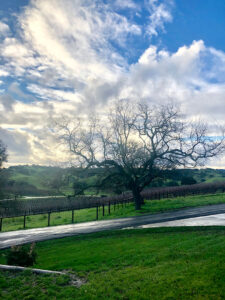[vc_row][vc_column][vc_column_text]by Wes Hagen
The people of Santa Barbara wine country have a personality quirk that is vaguely un-American: We are notoriously patient. Whereas petitioners in Paso Robles had no fewer than ten American Viticultural Areas approved simultaneously a few years back—a process that led the Alcohol and Tobacco Tax and Trade Bureau (TTB) to put a temporary moratorium on sub-appellations—we in Santa Barbara like to go the slower route, adding an AVA about every five to seven years. I should know, as I researched and wrote the petitions for four AVAs in Santa Barbara County.
We started in 1981 with the establishment of the second AVA in California and the third in the U.S.: Santa Maria Valley, known for its cool winds, fog, and sandy soils—perfect terroir for Chardonnay and Pinot Noir—as well as the venerated Bien Nacido Vineyard. The Santa Ynez Valley (est. 1983) covers a massive assortment of climates, soils, and plantings; in fact, within a 30-mile corridor from Lake Cachuma to Lompoc, it grows 72 varieties, more than anywhere else in the world. Sta. Rita Hills (est. 2000), carved out of the cool-climate area between Lompoc and the Buellton Flats, is a textbook Winkler Region I appellation. Happy Canyon of Santa Barbara (est. 2009) gave us a hot, arid growing area with large diurnal swings, perfect for Cabernet and Sauvignon Blanc. In my petition to establish the Ballard Canyon AVA (2013), I described it as a peripheral promontory with a marginal climate ideal for most Rhône varietals. The creation of the Los Olivos District (est. 2016) was necessary to express the “core” of the Santa Ynez Valley, containing as it does many of the appellation’s most important vineyard sources for Cabernet Franc, Sauvignon Blanc, and other French as well as Italian and Spanish wine varieties.
[/vc_column_text][vc_empty_space][vc_video link=”https://youtu.be/2URcH-fHhus” el_width=”70″ align=”center”][vc_empty_space][vc_column_text]On August 25, the TTB published its final ruling to approve Santa Barbara County’s seventh AVA: Alisos Canyon. Encompassing 5,774 acres, it’s the highly defined “heart” of the Los Alamos winegrowing subregion, which will likely require the designation of multiple AVAs in the future to account for its diversity of soil and climate types. Here’s what you need to know about it:
Climate: The Alisos Canyon AVA exhibits the distinct influence of the San Antonio Creek Valley, which runs directly from the mouths of the Alisos and Comasa canyons to the Pacific Ocean 20 miles to the west. The ingress of cooling marine winds and fog through the valley helps define the climate of the AVA as a Winkler Region II.
Soil: Soils are based on weathered sandstone and shale from the Paso Robles and Sisquoc formations, with a rare limestone streak running throughout the AVA. High calcium content from siliceous shale pebbles and marly limestone aids in grapeskin thickening, thus increasing extraction, color, and tannins in red varieties. The “clayey matrix” provides higher cation exchange capacity (CEC), which is beneficial as positively charged clay soil particles are necessary for the uptake of macro- and micronutrients by the vines.

Key Grapes: What should you try first? Syrah, Grenache, Viognier, and Cabernet Franc are the standouts for me. Look particularly for Thompson Vineyard designates from Dovecote Estate Winery (with which I have worked), Bedford Winery, The Ojai Vineyard, and Jaffurs Wine Cellars.
Located just two hours north of Los Angeles and 45 minutes from downtown Santa Barbara, Alisos Canyon AVA is a tiny but exceptional Rhône-focused region ready for exploration. Wines from the aforementioned producers as well as Sine Qua Non and Tensley will define the appellation until other growers start planting here and area winemakers produce new vintages.
Wes Hagen is the brand ambassador and former winemaker for J. Wilkes. He worked as winemaker and vineyard manager at Clos Pepe Vineyards and Estate Wines for 21 years and served on the board of directors for both Santa Barbara County Vintners and Sta. Rita Hills Winegrowers Alliance. Follow him on Twitter and Instagram @weshagen.[/vc_column_text][/vc_column][/vc_row][vc_row][vc_column][/vc_column][/vc_row]
